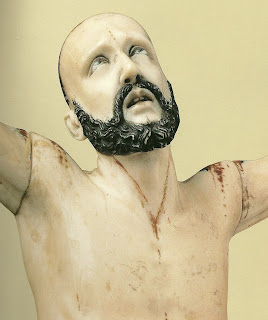Images of Christ in Ivory
In colonial Philippines, the Santo Cristo-- that is, the image of Christ Crucified-- was almost always the most expensive ornament a church may have. It has been rendered differently and through various media throughout the centuries, being painted, or made of wood, stone, or otherwise decorated with costly materials. In the Spanish tradition, rays of beaten gold or silver often extend from the arms of the cross, forming a sort of 'halo' or mandorla of sunbursts around the figure of the crucified. The corpus of the Santo Cristo was often done in ivory, considered the most expensive, and therefore, the most befitting, of the media in which the figure of Our Lord may be rendered. In the Philippines, as mentioned in the previous post, the Chinese excelled in this trade, eventually teaching the art to the native Filipino population. Ivory was sourced from Goa, itself a major hub of the ivory-related art; and in Macau, too, the tradition flourished. Notably, in the Philippines, the slightly askew, 'bent' shape of ivory images (a result of the natural curvature of elephant tusks), was seen as a sign of elegance and superior taste; the effect was also often replicated on non-ivory images.
In the aftermath of the revolution against Spain, many friars took a sizable share of the ivory images in the Philippines, back to their native country. As well, the galleon trade with Mexico ensured that these Far Eastern works of devotional art were duly represented in the New World. Here are some photos of various images of the Crucified in ivory. These images were found on Flickr; however, the exact provenances of these images, are still a matter of scholarly debate.
Photo source:
Apo Lakay's photostream on Flickr
These first two images are attributed to Leoncio Asuncion, one of the most renowned sculptors in 19th century Philippines. However, the image does not follow the conventions for the Santo Cristo as mostly found in the Philippines. A good overview on this may be read at the Flickr page where this photo was found: Sto. Cristo Expirante
Left: a Rococo style Sto. Cristo Moribundo, found at the San Agustin museum in Manila; and on the Right, three corpuses. The middle one is Filipino, while the two flanking it are thought to be Goan. Again, please visit Apo Lakay's photostream, which contains more information about these images.
Two more examples. Sadly, I regretted to make a mental note of the photostream(s) where I found these.
The image above may be found, if I remember correctly, in the Mexico city Cathedral. It is reputedly of Philippine provenance.
Finally:
This rather ornate, and sumptuously beautiful crucifix, is probably one of the most stunning I have ever laid eyes on. No word on the provenance, however. Notice the silver cantoneras and the rays emanating from the arms of the cross.
And, just for fun, here is a set of ivory images of Christ, that tell the story of the Via Crucis (link). These belong to a family in Iloilo, Philippines. From left to right, they depict Our Lord in prayer at Gethsemani; Nuestro Senor Cautivo (Our Lord Captive); Nuestro Senor de la Paciencia (Our Lord of Patience); Nuestro Senor de la Columna (Our Lord of the Column); the Ecce Home; and Nuestro Padre Jeus Nazareno (Our Father Jesus the Nazarene). This delightful image was found here: Via Crusis.




















1 comment:
Do you know the dimensions of the crucifix you describe here: "This rather ornate, and sumptuously beautiful crucifix, is probably one of the most stunning I have ever laid eyes on. No word on the provenance, however. Notice the silver cantoneras and the rays emanating from the arms of the cross."
I have one that we just inherited and are trying to find a value for. It comes from our Brazilian part of the family, but probably originated in Portugal during the 18th Century.
Post a Comment